Technology Exchange
Steel plate leveling and straightening
Overview
In modern industrial production, welding or other heating processes will leave residual stress in the metal material during the subsequent cooling process, which will lead to the distortion and deformation of the metal. This kind of deformation not only affects the appearance, but also affects the correct installation, and even causes all kinds of troubles to the final assembly, especially in the installation of complex, huge and precise equipment with a welding structure. For example, the shipbuilding industry with welded structures, mechanical industries such as structural beams, bridges, cranes, storage tanks (pressure vessels), and the electrical machinery industry of large transformer cabinets all have this problem.
Shipbuilding industry
In the shipbuilding industry, welding in shipbuilding is an indispensable process (such as the welding of bones, the welding of the side walls of the hull and the deck, etc.), and welding deformation has also become a headache. The corresponding hull The correction of the deformation has also become a follow-up work that must be completed, especially the thin steel plates used on military ships. After welding, the deck and side walls of the ship will produce more serious distortions. In order to correct this deformation, it often costs considerable The long time has seriously affected the efficiency of shipbuilding. The welded ship deck is shown in Figure 1.
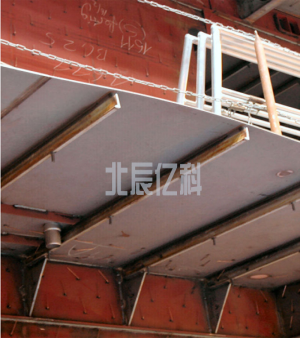 |
| Figure 1 Ship deck deformed by welding |
Leveling technology
In the shipbuilding industry, the welding deformation of the ship's deck and side walls has been studied for decades, but various deformation problems still exist. The thinner the hull deck, the more the deformation during welding transfers to the inside of the steel plate structure, making it more difficult to rectify.
Generally, the shape of flat plates, structural beams, plates, etc. are changed by heating metal materials. The so-called leveling is to shrink or shorten a large area or surface through heat. At present, the hull leveling technology includes flame leveling and induction heating leveling. These two leveling methods are described below.
Flame leveling
In the shipbuilding industry, the traditional leveling method uses flame leveling, that is, the flame directly heats the convex surface of the deformed area, and the thickness of the flame heating is very shallow. In the cooling process, the shrinkage of the steel plate on the heated side is larger than that on the unheated side, and the steel plate shrinks unevenly. Flame leveling, heating and cooling the convex surface, as shown in Figure 2.
 |
| Figure 2 Flame heating |
In the raised part, a lot of small areas are heated to make the steel plate flat, as shown in Figure 3.
 |
| Figure 3 Heating zone in the convex area of the steel plate |
The steel plate after the operator performs flame heating and flame leveling, as shown in Figures 4 and 5
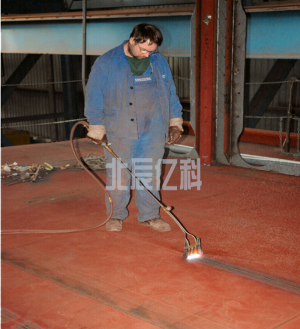 |
| Figure 4 The operator is performing flame heating |
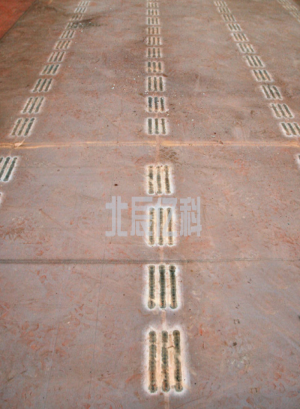 |
| Figure 5 Steel plate after flame leveling |
Flame straightening is usually used to treat steel plates with a thickness> 8mm. However, for the heating of thin steel plates, the heat in this way is easily transferred to the steel plate. At this time, the ribs in the heating area are also easily heated, and the hard ribs will be thermally deformed. In this way, heating the steel plate to the target temperature takes longer and burns more gas. For low carbon steel, the heating temperature for flame correction (natural cooling) is generally 700-800°C.
Flame leveling is achieved by heating the surface of the raised part to increase the stress on the heated surface to achieve a leveling effect, but it does not reduce the stress in the welding area. Although the effect of leveling can be achieved, it requires experienced operators. There are various problems such as overheating and uncontrollable surface, high noise, direct heating of the surrounding environment, and generation of toxic gases and smoke. At the same time, flame leveling can only pass Leveling can only be achieved by heating the raised side. So many problems eventually led to low work efficiency, high cost, and a lot of waste of manpower and material resources. In order to solve these shortcomings, Norway established a research institute in the 1970s to study new leveling methods. Instead of flame leveling, the first induction leveling equipment was finally developed. Through testing, using short coils to inductively heat thin plates (4-7mm thin plates are generally used in military ships). Facts have proved to be very effective in reducing the deformation of thin plates, and there is no defect caused by the heating method described above.
Induction heating leveling
Principle of induction heating
Induction heating leveling, that is, the alternating current passes through the inductor to generate "induced current" in the steel plate, so that the current in the concentrated heating area causes the temperature to rise rapidly, and the material in the heating area expands vertically; when the steel plate is cooled, the heating area The shrinkage of the material in all directions is basically the same, resulting in long-lasting deformation, making the plate shorter and straightened, so as to achieve the effect of leveling. The inductor heats the raised steel plate, as shown in Figure 6.
 |
| Figure 6 Schematic diagram of induction heating steel plate |
The red area is the heating area, and the sensor above the red area. During induction heating, the red heating area can be seen under the steel plate, as shown in Figure 7.
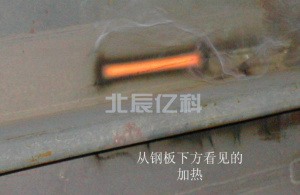 |
| Figure 7 The heating state under the steel plate during induction heating |
Induction heating, rapid and penetrating heating, promotes rapid vertical expansion of the heating area. When cooling, the material in the heating area will shrink uniformly in all directions, making the convex parts of the sheet flat. The shrinkage direction of the steel plate cooling, as shown in Figure 8.
 |
| Figure 8 The direction of steel plate cooling shrinkage |
Heating part
In the shipbuilding industry, the induction heating part is mainly close to the heat shrinkage of the weld, as shown in Figure 9. The heating effect in this area is very obvious. The heating and shrinkage of the weld on one side of the weld can eliminate the two deformations of protrusions and depressions, as shown in Figure 10.
 |
| Figure 9 Heating at the weld |
 |
| Figure 10 Heating on one side of the weld |
heating time
Figure 11 shows the relationship between the surface of the steel sheet and the time it takes to heat the entire thickness.
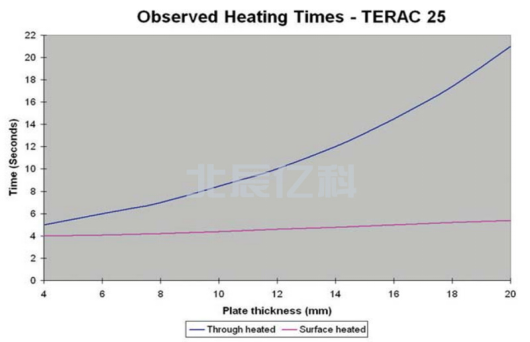 |
| Figure 11 The relationship between steel plate thickness and heating time |
From Figure 11 (source EFD test data), it can be seen that the surface of the steel plate can be heated to the Curie temperature (740℃) within 4s. According to the actual thickness of the steel plate, the time to continue heating is determined. When the steel plate is made of low-carbon steel or low-alloy structural steel, the heating temperature is 600~800℃. At this time, the surface of the steel plate is fuchsia. If the heating temperature is too high, that is, overheating, it is easy to damage the internal structure of the metal.
Frequency selection
According to EFD data, the induction heating leveling method adopts a working frequency of about 20KHz.
Heating mode
The heating mode adopts the automatic heating mode. According to the thickness of the steel plate, the heating time is determined after testing, and it is set as the heating time parameter in the automatic mode.
Heating process
For the induction leveling of the deck and side walls of the hull, heating and leveling are generally selected near the weld, and the welding is performed on one side of the weld to eliminate the two deformations of protrusions and depressions. Generally, multiple heating and leveling are required, according to the sensor area. The size is up to you. The first heating, as shown in Figure 12.
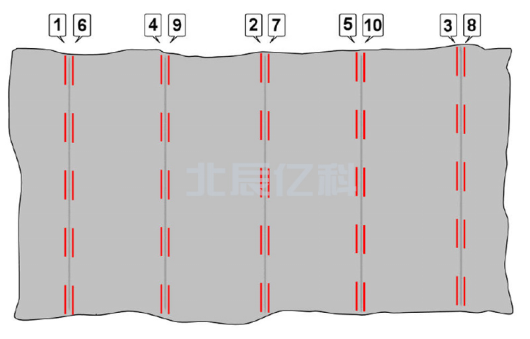 |
| Figure 12 First heating |
The heating area is selected on both sides of the weld, from the outside to the inside, evenly distributed, and evenly heated. The second heating zone is shown in Figure 13.
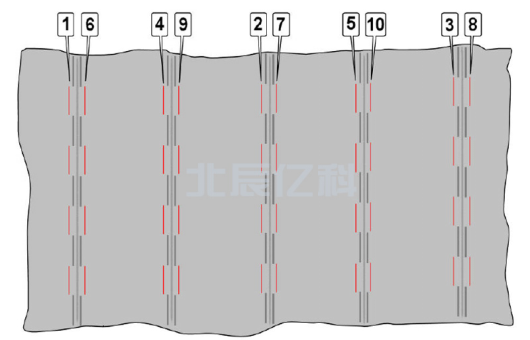 |
| Figure 13 Second heating |
This heating method is equal, complete, and does not omit, making the heating effect more convenient and better.
Heating of the side walls of the hull (heating on the vertical surface), as shown in Figure 14.
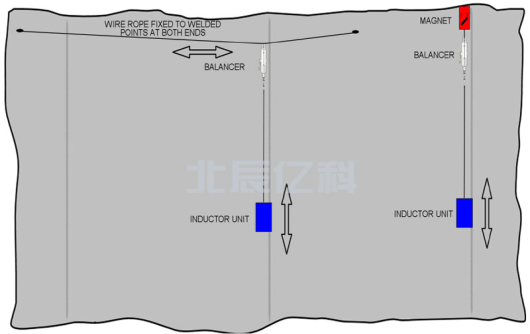 |
| Figure 14 Vertical heating |
The heating on the vertical surface uses a steel wire (or magnet) with a balancer to suspend the sensor unit for leveling.
Corrective evaluation
After the correction, what is the result of the correction to be considered qualified. Generally, the deformation of the correction area should be measured before, during, and after heat correction. Compared with flame heat correction, the process of induction heat correction can be controlled more precisely. The maximum allowable deformation of the deformation area is 6mm. The evaluation of the thermal correction effect is determined by the proportion of the structure whose deformation is within the error range. It should be noted that the purpose of heat correction is not to produce a completely flat deck, but to produce a deck within the error range. According to EFD data, after induction heat correction, 93%~95% of the decks are within the error tolerance; after flame heat correction, only 51%~56% of the decks are qualified.
Comparison of induction heating and flame
Compared with flame, induction heating solves the problems of flame heating, and its advantages are as follows:
1) Repeatable heating and controllable heating;
2) Full penetration heating of steel plates up to 20mm thick;
3) Mishandling will not cause the material to overheat (magnetic core material)
4) No toxic gas will be generated in the heating area;
5) Reduce smoke when leveling painted or primed floors;
6) Reduce the risk of burning surrounding materials;
7) No noise
8) All leveling work is carried out on the same side of the board;
9) Simple to use, reducing the requirement for skilled workers and the dependence on operation level;
10) Easy to operate
11) Reduce assembly costs
12) Reduce the consumption of manpower and energy, reduce the cost, and no longer need a large amount of combustible gas and oxygen
Summarize
This report mainly elaborates on the leveling process of induction heating steel plate, and compares it with flame leveling. Induction heating leveling has obvious advantages, especially the leveling of thin steel plate. At present, in the shipbuilding industry, it is the only feasible method that can achieve the ideal correction effect at one time.


 Scan and follow!
Scan and follow!